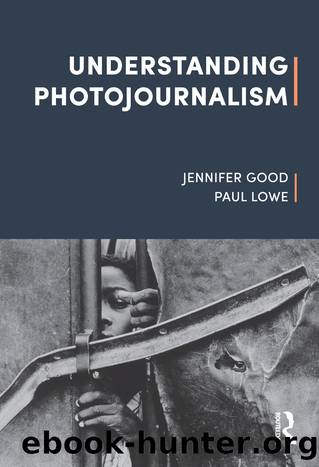Understanding Photojournalism by Jennifer Good

Author:Jennifer Good
Language: eng
Format: epub
Publisher: Taylor and Francis
Published: 2017-06-15T00:00:00+00:00
Legacies of the colonial gaze: representing famine
Curiosity about the world and the impulse to document threatened cultures are not, of course, the only contexts in which contemporary Western photographers engage with non-Western subjects. Much more frequent and high profile is the coverage of humanitarian stories. From breaking news of natural disasters to longer-term charity campaigns, humanitarian photojournalism raises the stakes of ethically responsible representation because of the huge potential for regression into stereotypes of victimhood. The coverage of African famine by Western photojournalists has proven in particular to be a minefield of stereotypes and entrenched visual cliché, because it is an area in which so many questions of power and representation collide.
Figure 5.5 Finn Frandsen, November 1984, Ethiopian famine victim (AFP/Getty Images).
Famine, especially in Africa, has its own unmistakable iconography. The visual cues of the emaciated black body, empty eyes, distended belly, tears and 'flies on eyes' are its hallmarks. David Campbell has argued that this iconography 'should be roundly condemned as simplistic, reductionist, colonial and even racist'.13 Imagery such as this (as seen in Figure 5.5) is implicated, he says, within the legacies of colonialism not by any association with the exotic as such but because it perpetuates a stereotypical power relationship between helpless, dysfunctional Africa and the rich, compassionate West:
The message is that someone is suffering, and that we should be sympathetic to his or her plight and moved to do something. However, the lack of contextual support means that viewers are most likely to regard action to alleviate suffering as coming from outside. Indigenous social structures are absent and local actors are erased from these images. There is a void of agency and history with the victim arrayed passively before the lens so their suffering can be appropriated. This structuring of the isolated victim awaiting external assistance is what invests such imagery with colonial relations of power.14
Associated with these colonialist attitudes is the tendency, all too visible in the British tabloid press, of representing Africa as a whole, undifferentiated continent defined by famine. Beyond simple ignorance, this is a throwback from an era in which Africa was 'the dark continent': a vast and mysterious mass awaiting exploration only by the brave. Even the more innocuous misconception of the whole of Africa as suffering a perpetual state of starvation is a destructive stereotype that photography often does little to dispel. Sometimes called the 'Live Aid Legacy', this view is associated
Figure 5.6 Paul Lowe, 1992, Mogadishu, Somalia (Paul Lowe).
Paul Lowe's photograph highlights the media circus surrounding a malnourished boy during 'Operation Restore Hope', the American intervention in Somalia following the overthrow of its president.
in particular with the devastating Ethiopian famine of 1984 (Figure 5.5), which prompted British celebrities led by Bob Geldof to mount a high-profile publicity campaign that succeed in raising a large amount of money in a short amount of time, but resulted in a long-lasting distortion of Africa in the British public imagination.15
The very uncomfortable idea of the famine victim being 'arrayed passively before the lens' is illustrated in this photograph (Figure 5.
Download
This site does not store any files on its server. We only index and link to content provided by other sites. Please contact the content providers to delete copyright contents if any and email us, we'll remove relevant links or contents immediately.
| Photo Essays | Photojournalism |
Shoot Sexy by Ryan Armbrust(17609)
Portrait Mastery in Black & White: Learn the Signature Style of a Legendary Photographer by Tim Kelly(16914)
Adobe Camera Raw For Digital Photographers Only by Rob Sheppard(16861)
Photographically Speaking: A Deeper Look at Creating Stronger Images (Eva Spring's Library) by David duChemin(16554)
Bombshells: Glamour Girls of a Lifetime by Sullivan Steve(13928)
Art Nude Photography Explained: How to Photograph and Understand Great Art Nude Images by Simon Walden(12903)
Perfect Rhythm by Jae(5277)
Pillow Thoughts by Courtney Peppernell(4172)
The Book of Joy by Dalai Lama(3857)
Good by S. Walden(3449)
The Pixar Touch by David A. Price(3331)
A Dictionary of Sociology by Unknown(2924)
Fantastic Beasts: The Crimes of Grindelwald by J. K. Rowling(2906)
Stacked Decks by The Rotenberg Collection(2773)
Humans of New York by Brandon Stanton(2742)
Read This If You Want to Take Great Photographs by Carroll Henry(2639)
On Photography by Susan Sontag(2542)
Photographic Guide to the Birds of Indonesia by Strange Morten;(2464)
Insomniac City by Bill Hayes(2457)
